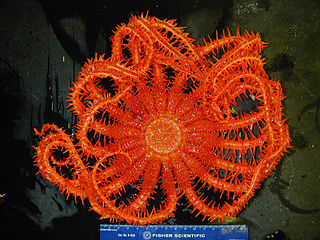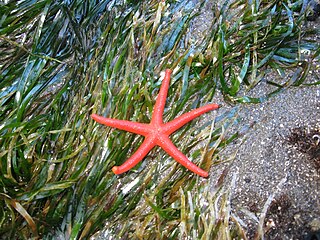
Asterias is a genus of the Asteriidae family of sea stars. It includes several of the best-known species of sea stars, including the (Atlantic) common starfish, Asterias rubens, and the northern Pacific seastar, Asterias amurensis. The genus contains a total of eight species in all. All species have five arms and are native to shallow oceanic areas of cold to temperate parts of the Holarctic. These starfish have planktonic larvae. Asterias amurensis is an invasive species in Australia and can in some years become a pest in the Japanese mariculture industry.

The Echinasteridae are a family of starfish in the monotypic order Spinulosida. The family includes eight genera and about 133 species found on the seabed in various habitats around the world.

Astropecten is a genus of sea stars of the family Astropectinidae.

The Asteriidae are a diverse family of Asteroidea in the order Forcipulatida. It is one of three families in the order Forcipulatida.

Goniasteridae constitute the largest family of sea stars, included in the order Valvatida. They are mostly deep-dwelling species, but the family also include several colorful shallow tropical species.

Ceramaster is a genus of cushion stars in the family Goniasteridae. The species in this genus have no arms. They live in deeper waters than most sea stars.

The Forcipulatida are an order of sea stars, containing three families and 49 genera.

The Brisingids are deep-sea-dwelling starfish in the order Brisingida.

Henricia leviuscula, commonly called the Pacific blood star, is a species of sea star found along the Pacific coast of North America.

Luidia is a genus of starfish in the family Luidiidae in which it is the only genus. Species of the family have a cosmopolitan distribution.

Solaster is a genus of sea stars in the family Solasteridae.

The Brisingidae are a family of starfish found only in the deep sea. They inhabit both the Atlantic and Pacific Oceans at abyssal depths, and also occur in the Southern Ocean and around Antarctica at slightly shallower depths.

The Freyellidae are a family of deep-sea-dwelling starfish. It is one of two families in the order Brisingida. The majority of species in this family are found in Antarctic waters and near Australia. Other species have been found near New Zealand and the United States.

Pterasteridae is a family of sea stars in the order Velatida, consisting of eight genera.

Myxasteridae is a family of deep-sea velatid sea stars containing nine species in three genera.
Aleutihenricia is a genus of starfish in the family Echinasteridae in the order Spinulosida.

Pteraster is a genus of sea stars in the family Pterasteridae.
Asterias versicolor is a species of starfish native to the southern coasts of Japan southwards to the South China Sea.

Pseudarchaster is a genus of echinoderms belonging to the family Pseudarchasteridae.

Ophidiaster is a genus of echinoderms belonging to the family Ophidiasteridae.


















